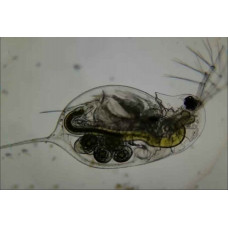A suborder of crustaceans in the order Fyllopoda. They are ubiquitous in marine and freshwater environments. The most common freshwater crustaceans are the branchiopods of the genera Dafhnia, Bosmma and Synura. They belong to the zooplankton. They are the main food for the vast majority of fish, and branchiopods are used in fisheries as food for reared juvenile fish.
To date, more than 1000 species are known, with many more undescribed. The oldest Diplostraca fossils date from the Jurassic period, although their modern morphology suggests that they originated much earlier. Some have also adapted to life in the sea, the only Branchiopoda to do so, although a few anostracans live in hypersaline lakes. Most are 0.2-6.0 mm (0.01-0.24 inches) long, with a downward facing head, a single median compound eye, and a carapace covering an apparently unsegmented thorax and abdomen. Most species exhibit cyclic parthenogenesis, in which asexual reproduction is sometimes supplemented by sexual reproduction in which eggs are laid, allowing the species to survive in harsh conditions and disperse to distant habitats.
They are mostly 0.2-6.0 mm (0.01-0.24 in) long, with the exception of Leptodora, which can reach 18 mm (0.71 in). The body is clearly unsegmented and has a folded carapace covering the thorax and abdomen. The head is depressed and may be separated from the rest of the body by a 'cervical sinus' or notch. All but two genera have a single black compound eye along the midline of the animal and often a single ocellus. The head also has two pairs of antennae - the first are small, unsegmented appendages, while the second are large, segmented and branched, with strong muscles. The former antennae have olfactory bristles, while the latter are used by most species for swimming. The pattern of bristles on the second antennae is useful for identification. The part of the head in front of the first antennae is called the rostrum or 'beak'. The mouthparts are small and consist of an unpaired upper lip, a pair of lower jaws, a pair of upper jaws and an unpaired lip. They are used for feeding on "organic detritus of all kinds" and bacteria. The thorax has five or six pairs of paddle-like, leaf-like appendages, each covered with numerous hairs or bristles. Carbon dioxide is lost and oxygen absorbed through the body surface.
With the exception of a few purely asexual species, the life cycle of Diplostraca is dominated by asexual reproduction with rare periods of sexual reproduction, known as cyclic parthenogenesis. Under favourable conditions, reproduction by parthenogenesis occurs over several generations, producing only female clones. As conditions deteriorate, males emerge and sexual reproduction occurs. This results in the formation of dormant eggs that remain dormant for long periods of time. These ephippial eggs can be transported over land by the wind and hatch when conditions are favourable, giving many species a very wide - even cosmopolitan - distribution. With the exception of the genus Leptodora, which has the metanauplius stage, the nauplius larval stage is absent in Diplostraca.
Diplostraca nest within crustaceans and are most closely related to the order Cyclestherida, of which Cyclestheria is the only living species. Although several Palaeozoic fossils have been claimed to be Diplostraca fossils, none of these records can be confirmed. The oldest confirmed records of Diplostraca are from the Early Jurassic in Asia. Jurassic fossils can be attributed to both modern and extinct groups, suggesting that the initial radiation of the group occurred before the Jurassic, probably in the Late Palaeozoic.
According to the World Register of Marine Species, Cladocera is synonymous with the suborder Diplostraca, which is included in the class Branchiopoda. Both names are currently in use. The superorder forms a monophyletic group with 7 suborders, about 24 families and over 11,000 species. Many other species are undescribed. The genus Daphnia alone contains about 150 species. Many groups of water fleas are cryptic species or species clusters.
Diplostraca (Cladocera)
Tags: Diplostraca (Cladocera)



